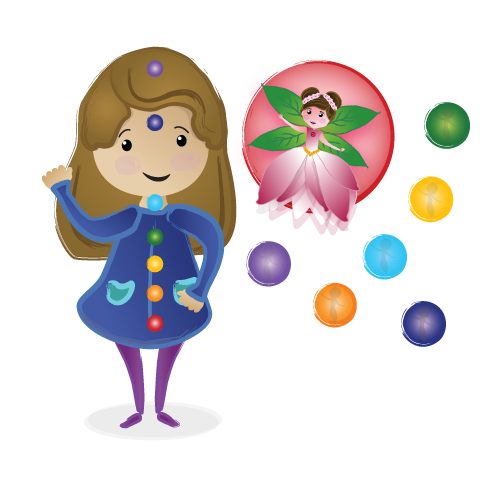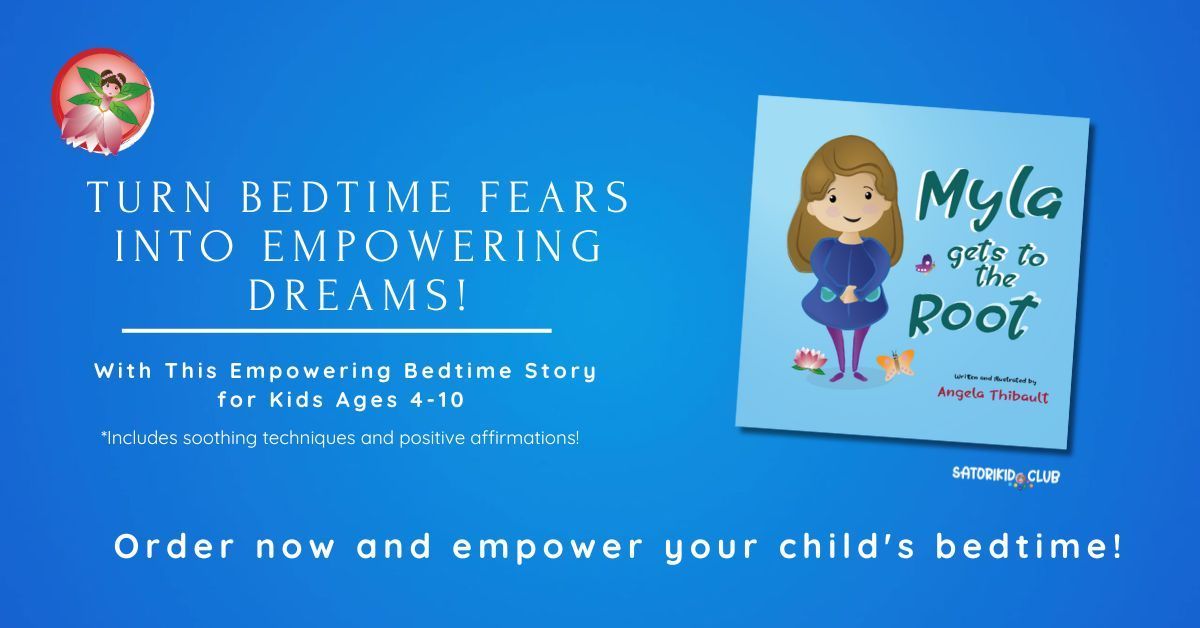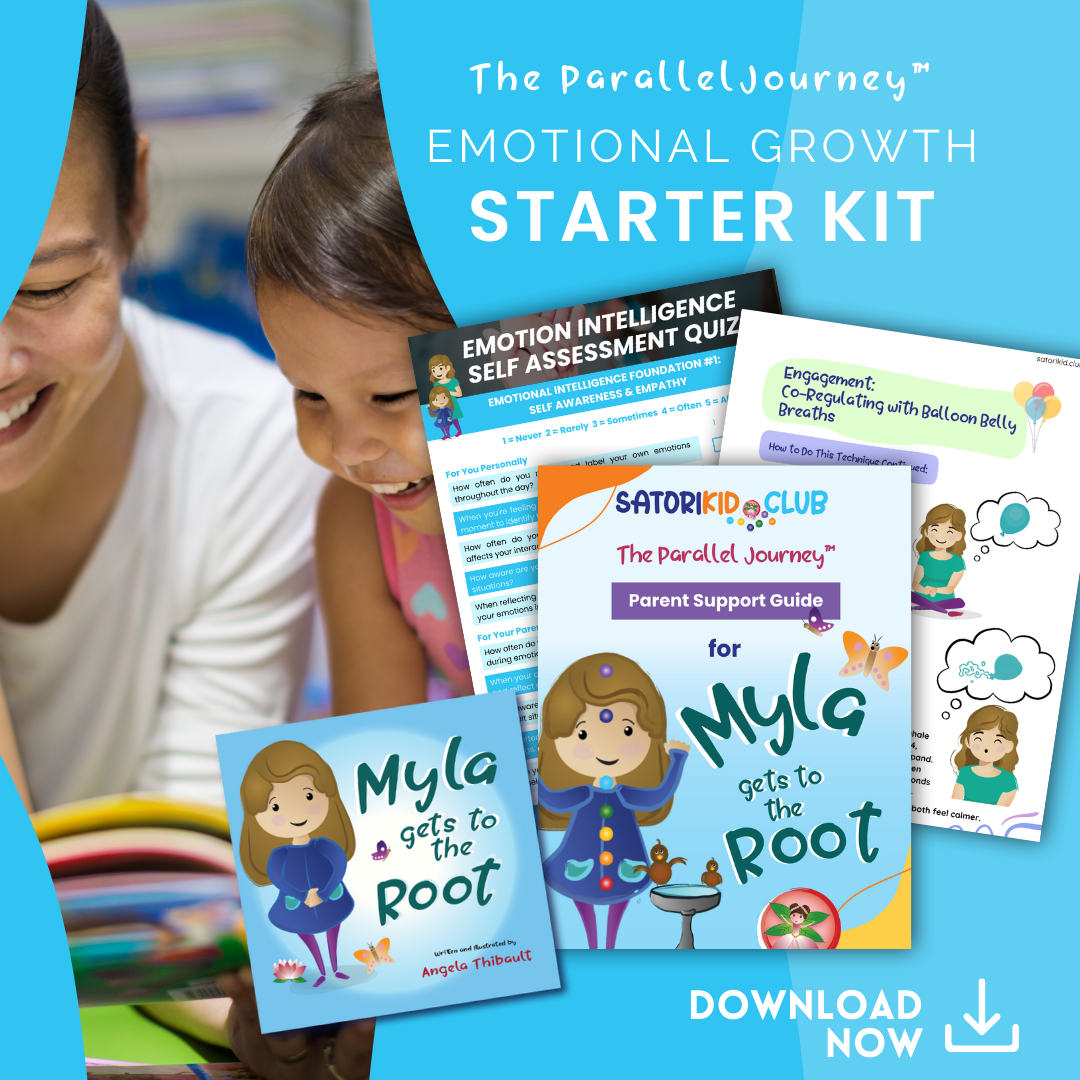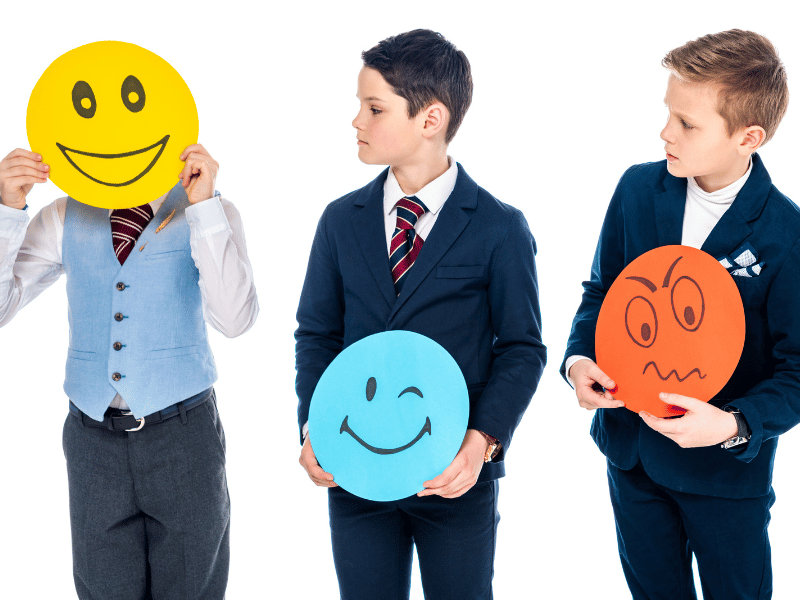Start your journey here
5 Simple Strategies to Help Your Child Manage Big Emotions
All activities should be supervised by an adult.
Share

Learn 5 Simple Strategies to Help Your Child Manage Big Emotions
When my kids were little, I used to think managing their emotions would be as simple as saying, "It's okay, just calm down." But as a parent, I've been in situations where I was upset, and someone told me to "just calm down." If you've experienced this, How did it turn out?
Let me tell you, the few times I did try to say, "Just calm down," it usually made things much worse.
Back then, I didn't realize kids don't come pre-programmed with emotional regulation skills. Big emotions can feel overwhelming for them—and let's face it, for us, too! But helping your child navigate these feelings doesn't have to feel like climbing a mountain.
Over the years, I've learned a few strategies that not only stop tantrums in their tracks, but also help kids develop lifelong tools for managing emotions. These are five simple strategies that have worked wonders for my family, and I'm confident they'll work for yours, too.

1. Teach Kids to Name Their Feelings to Help Them Manage Big Emotions
One of the most surprising things I learned as a parent is how much power there is in naming emotions. For kids, "I'm mad" or "I'm sad" might be the only option initially. But when you teach them words like frustrated, disappointed, or overwhelmed, they start to understand their emotions differently.
Once, when my daughter was about 4 years old, she yelled, "I am very mad at you!" This was after I told her we couldn't stay at the park anymore. Like, I am not gonna lie; it stings when your kid yells at you. After some deep internal eye-rolling, instead of brushing it off, I asked, "Do you think you're mad because I told you to do something without asking how you felt, or are you disappointed because you wanted to stay longer?" Her whole face changed she squinched up her nose and said. "I'm disappointed," she said.
That moment of identification is so helpful. I have found that naming and expressing emotions correctly can also help us identify WHY we feel the way we are. This allows us to deal with the issue sooner and maybe even get a chance to heal it while it is happening. Understanding and correctly expressing emotions can foster a sense of connection and empathy, both for your child and for yourself.
What You Can Do:
- Create an emotions chart with faces and labels to help younger kids connect words to feelings.
- Model this yourself. Share your feelings with your child, saying things like, "I'm feeling quite frustrated right now because I am running late, so I will take a deep breath and try to figure out a way to be on time."
This not only shows your child how to manage their emotions, but also that it's okay to feel upset sometimes.

2. Understand Age and Developmental Skills is the Key to Managing Big Emotions
I remember expecting so much from my son Tony when he was two years old. I needed him to be "good" or "easy" because I was adjusting to life with a newborn. I expected him to follow directions, handle his emotions, and behave like a little adult. Looking back, it's nonsensical. He was just a baby—a curious, emotional, unpredictable two-year-old navigating his world.
Now, when I see two-year-olds, I think they're still so little! But at the time, I felt the weight of societal and family expectations pressing down on me. If Tony had acted out, I think it would have reflected on me as a mother. That pressure led to unfair expectations for him, which wasn't his fault—or mine.
Understanding your child's developmental stage dramatically impacts how you view a situation. A two-year-old isn't being difficult; they're learning. A six-year-old doesn't lack respect; they're developing independence. Aligning your expectations with their age and abilities can lift a lot of expectations of both you and your child, providing a sense of comfort and reassurance that these stages are normal and, while not easy, you will definitely get through them.
What You Can Do:
Learn about age-appropriate developmental milestones from credited sources, such as:
The Whole-Brain Child by Daniel J. Siegel and Tina Payne Bryson
Focuses on nurturing emotional and social development using age-appropriate strategies.
But remember, every child grows at their own pace.
When feeling overwhelmed by their behaviour, ask yourself: "Am I expecting too much for where they are right now?"
Ignore the noise from societal and family pressures. Your parenting journey is unique, and so is your child's development.

3. Nurture Your Child's Emotional Growth to Help Them Manage Big Feelings
When kids are upset, our instinct is often to fix it: stop the crying, solve the problem, and move on. But emotions aren't something you can fix; you can help them process them.
One day, my daughter came home from school, slammed her backpack down, and said, "Nobody likes me." My immediate old reaction was to jump in and say, "That's not true, of course people like you!" But over time and through a lot of inner work, I learned to get curious and listen to what was being said. Ask before assuming, so I asked, "What makes you say that?" to which she replied, "All the girls won't talk to me." so I continued with more open-ended questions like," That sounds really hard. Do you want to talk about it?" she didn't need me to fix her feelings; she just needed me to sit with her in them.
So many times, we as parents are quick to try to fix our children's uncomfortable feelings because we don't know how to sit with uncomfortable feelings ourselves.
What You Can Do:
- Acknowledge their emotions without judgment. Say things like, "It's okay to feel upset right now."
- Ask open-ended questions like, "What made you feel that way?" instead of jumping in with solutions.

4. Create a Calm-Down Toolkit to Give Your Child Control Over Big Emotions
As parents, we like to think we are so much more evolved than our children. But have you ever needed space or wished you had the right tools to work through your feelings? Well, kids are absolutely no different. Their entire life journey is about learning to eventually become independent. It's our job to provide them with the tools to safely navigate their way through their big feelings while simultaneously supporting them. That's where creating something like a calm-down toolkit can be a lifesaver.
When my kids were younger, we made a calm-down toolkit together. We filled it with squishy stress balls, colouring books, and even a tiny blanket they could wrap around themselves. Here is how we did it: if you're feeling overwhelmed, name your feeling and express your need to grab and use something from the toolkit. Providing your child with a calm-down toolkit can give you a sense of control and confidence, knowing that you've equipped them with the tools to manage their big emotions.
What You Can Do:
- Let your child help pick what goes inside their kit. Some ideas are fidget toys, a journal, crayons, or a favourite stuffed animal.
- Create a cozy "calm corner" in your home where they can use their toolkit when emotions feel too big.

5. Model Emotional Regulation it Teaches Kids to Manage Big Emotions
Here's the hard truth: kids learn more from what we do than what we say. If we yell, panic, or shut down when things get tough, they'll mirror that.
I'm not perfect at this (as you saw in my tissue box story in my blog post, 6 Surprising Secrets to Raising an Emotionally Intelligent Child), but I've learned to model emotional regulation as much as possible. If I'm stressed, I'll say, "I'm feeling overwhelmed, so I'm going to take a moment to step away and breathe." Seeing me handle my emotions calmly helps my kids see that it's possible—and gives them permission to try it, too.
An example of this was this past Christmas; now that we are adults, we are a good example. We were in the significant crunch of preparing for the entire family to descend upon us as we were hosting for Christmas Eve, and it was the usual Christmas Chaos. My now-grown daughter offered to help us prepare. As time ticked down, I started to become emotional as I was getting stressed, So I stated, "I am feeling overwhelmed worrying about managing everyone's feelings when they get here." she replied, "That's understandable, but you don't have to manage everyone feeling you just have to have fun yourself." Later, when she got overwhelmed by the Christmas chaos," she looked at me and said Mom, sit with me; I need a hug. "she proceeded to chant "we can do this" until she felt more regulated and we laughed. In the past, stress might have devolved into sniping at each other over nothing till it grew out of hand, and now we use statements and techniques like co-regulations as our everyday routine; you might think a Cozy corner is too much like a time-out or overkill but starting the skill when she was younger to step away meant she knew to identify she needed to sit down and being shown how to co-regulate meant she knew to ask for a hug and practice a mantra.
What You Can Do:
- Narrate your emotions and the steps you're taking to manage them.
- Be honest about mistakes. If you lose your cool, take time to repair, say, "I'm sorry I yelled. That wasn't okay, and I'm working on handling my frustration better."
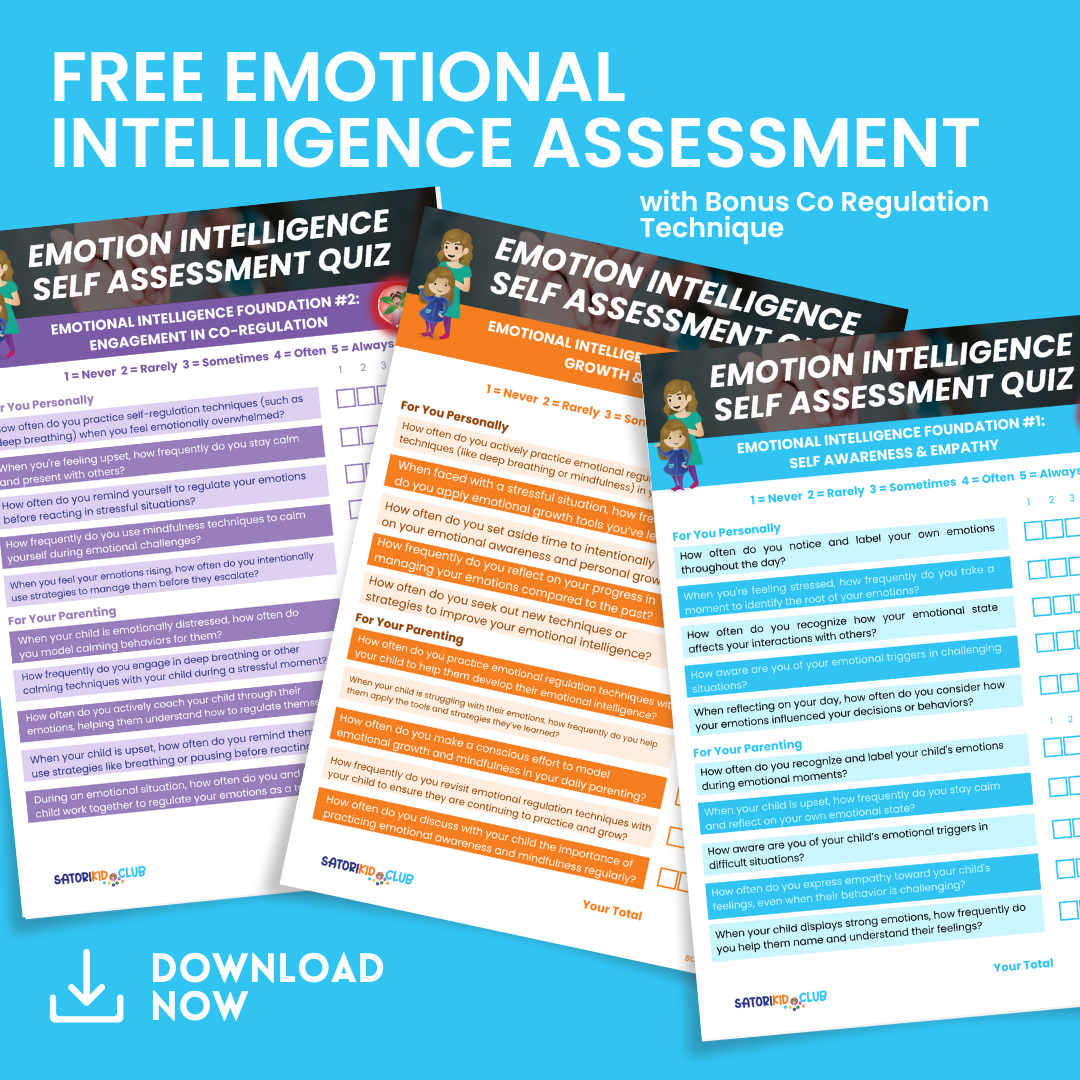
Conclusion:
Helping your child manage big emotions isn't about stopping the tears or fixing every tantrum. It's about giving them the tools to understand and handle their feelings healthily—and modelling those tools yourself.
These five strategies aren't quick fixes, but they've made a world of difference in my family.
Ready to take the first step and want to see where you are I have created a free Emotional Intelligence Assessment for you to download.

Angela Thibault
Angela Thibault is a mother of two, a passionate children’s author, and the founder of Satori Kid Club and The Parallel Journey™.
